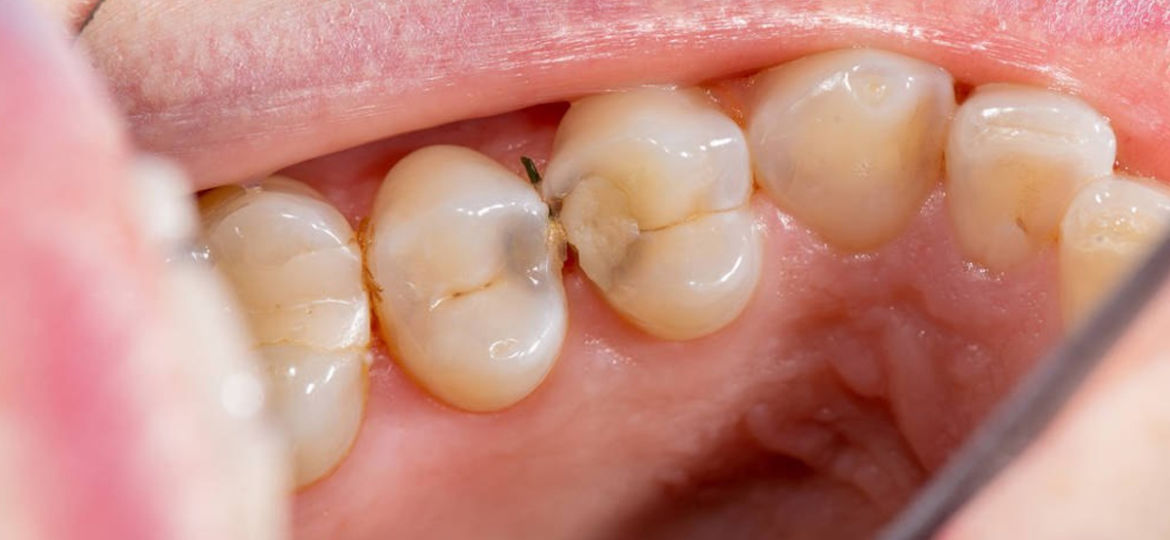What Tooth Decay Looks Like: Unveiling the Appearance of Cavities

Tooth decay may initially appear as a whitish or chalky discoloration on the enamel, while more advanced cases can display a brown or black color. The early stages of cavities are often difficult to detect without professional examination.
Caveat: most cases do not have distinguishable red alerts. As cavities progress, they can take on a dark spot or opening on the surface of the tooth, resembling yellow, brown, or black staining. Tooth decay can cause symptoms such as toothache, sensitivity to hot, cold, or sweet food and drinks, gray or black spots on teeth, and bad breath.
If left untreated, decayed teeth can lead to further damage and infection. It is important to see a dentist for proper diagnosis and treatment.
The Early Stages Of Tooth Decay
While it is usually difficult to see a cavity in its early stages, some cavities start with a whitish or chalky appearance on the enamel of your tooth. More serious cases of tooth decay can have a discolored brown or black color. However, most often there are no distinguishable red alerts.
Cavities on smooth surfaces are less common, but they’re typically right next to your gums and the enamel looks whitish or brown.
Discoloration: Teeth with cavities may appear yellow, brown, or black.
Pain: Throbbing pain in your teeth is usually a sign of an infection.
Grey, brown or black spots appearing on your teeth.
Tooth decay can be repaired by using minerals from saliva and fluoride from toothpaste or other sources. However, if the decay process continues, more minerals are lost, and the enamel becomes weakened and destroyed, forming a permanent damage known as a cavity. A dentist will need to repair the cavity with a filling.
If you suspect tooth decay, it is important to see a dentist for proper diagnosis and treatment.
Advanced Tooth Decay
| What Tooth Decay Looks Like |
| Advanced Tooth Decay |
| Discolored Brown or Black Color |
While it is usually difficult to see a cavity in its early stages, some cavities start with a whitish or chalky appearance on the enamel of your tooth. More serious cases of tooth decay can have a discolored brown or black color. However, most often there are no distinguishable red alerts. Cavities on smooth surfaces are less common, but they’re typically right next to your gums and the enamel looks whitish or brown. Discoloration: Teeth with cavities may appear yellow, brown, or black. Pain: Throbbing pain in your teeth is usually a sign of an infection. Cavities on molars tend to look like small, black, or brown spots. They may be difficult to see at first, but they will gradually become more noticeable.
Are you curious as to what tooth decay looks like? We have a ton of real photos of cavities that will satisfy your curiosity. Symptoms of tooth decay include toothache, tooth sensitivity, grey, brown, or black spots appearing on your teeth, and bad breath. Enamel can repair itself by using minerals from saliva and fluoride from toothpaste or other sources. But if the tooth decay process continues, more minerals are lost, leading to the formation of a permanent cavity.
Dark spots on teeth are an indication of rotting teeth.
Identifying Cavities And Treatment
While it is usually difficult to see a cavity in its early stages, some cavities start with a whitish or chalky appearance on the enamel of your tooth. More serious cases of tooth decay can have a discolored brown or black color. However, most often there are no distinguishable red alerts. A cavity will look like a dark spot on the tooth, typically yellow, brown, or black in color. Cavities on smooth surfaces are less common, but they’re typically right next to your gums and the enamel looks whitish or brown. Cavities on molars tend to look like small, black, or brown spots. They may be difficult to see at first, but they will gradually become more prominent. Typically, a cavity shows up on an X-ray as a darker spot or a shadow on a tooth.
If you’re curious, there are a ton of real photos of cavities available that will satisfy your curiosity.
- toothache – either continuous pain or occasional sharp pain
- tooth sensitivity – tenderness or pain when eating or drinking hot, cold, or sweet foods
- gray, brown, or black spots appearing on your teeth
- bad breath
Enamel can repair itself by using minerals from saliva, and fluoride from toothpaste or other sources. However, if the tooth decay process continues, more minerals are lost, leading to weakened and destroyed enamel, forming a cavity. A cavity is permanent damage that requires a dentist to repair with a filling.

Credit: www.minthilldentistry.com
Significance Of Decay Detection
Tooth decay can be identified by a whitish or chalky appearance on the enamel of the tooth, while more serious cases may have a discolored brown or black color. Cavities on smooth surfaces often appear whitish or brown near the gums.
Discoloration and throbbing pain are also signs of tooth decay.
| When it comes to tooth decay, it can be difficult to spot in its early stages. However, some cavities may present themselves with a whitish or chalky appearance on the enamel of the tooth. As the decay progresses, the color may become discolored and appear brown or black. Cavities on smooth surfaces are less common but can be seen next to the gums and appear whitish or brown. Other signs of tooth decay include yellow, brown, or black discoloration, throbbing pain, and darkened areas or openings on the tooth’s surface. Regular dental check-ups are crucial in identifying and addressing tooth decay early on. It’s important to note that enamel can repair itself with minerals from saliva and fluoride, but if the decay process continues, a cavity will form that needs to be repaired by a dentist. Natural remedies for preventing tooth decay include maintaining good oral hygiene practices, having a balanced diet, and using fluoride toothpaste. Remember that early detection and preventative measures are key to maintaining good oral health. |
Frequently Asked Questions On What Tooth Decay Looks Like
How Do I Know If My Tooth Is Decaying?
To determine if your tooth is decaying, look for signs such as a whitish or chalky appearance on the enamel, discolored brown or black spots, tooth sensitivity to hot, cold, or sweet foods, and bad breath. If you notice any of these symptoms, it’s important to visit a dentist for proper diagnosis and treatment.
Can Tooth Decay Be Fixed?
Tooth decay can be fixed by a dentist with a filling. Enamel can repair itself with the help of saliva and fluoride, but if the decay continues, a cavity forms. Untreated cavities can lead to further damage to the tooth.
If you notice dark spots or discoloration, it is important to see a dentist as soon as possible. Regular dental check-ups can help detect and treat tooth decay early.
What Does Rotting Teeth Look Like?
Rotting teeth can appear with dark spots or discoloration on the surface, such as yellow, brown, or black. These signs indicate tooth decay, and if left untreated, decay can spread and cause further damage to the teeth. It is important to see a dentist if you notice any discoloration to prevent further deterioration.
What Are The 5 Stages Of Tooth Decay?
The 5 stages of tooth decay progress as follows: 1. Whitish or chalky appearance on tooth enamel. 2. Brown or black discoloration on tooth enamel. 3. Small black/brown spots on molars. 4. Darkened area or opening on tooth surface. 5.
Decay visible on X-ray as shadow or darker spot. To prevent further decay, see a dentist for treatment.
Conclusion
Tooth decay can present itself in various ways, making it essential to understand what to look for. In its early stages, cavities may appear whitish or chalky on the enamel. As the decay progresses, the affected tooth may develop a yellow, brown, or black discoloration.
However, it’s important to note that not all cavities exhibit obvious signs right away. Regular dental check-ups are crucial to detecting and treating tooth decay before it worsens. Being aware of these visual cues can help you recognize when it’s time to seek professional dental care and prevent further damage.





